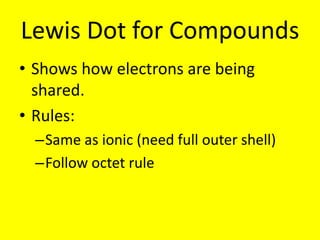Lewis dot compounds
•
1 gefällt mir•921 views
The document discusses Lewis dot diagrams, which use dots to represent valence electrons in atoms and lines to represent shared electrons between atoms in chemical compounds. It explains that atoms share electrons to achieve stable full outer shells like the octet rule, and that this electron sharing can be represented as pieces of a jigsaw puzzle fitting together. Examples of Lewis dot diagrams are given for the compounds water, methane, and phosphorus trichloride.
Melden
Teilen
Melden
Teilen

Empfohlen
Empfohlen
Weitere ähnliche Inhalte
Was ist angesagt?
Was ist angesagt? (20)
Review of Bonding and Lewis Structures for Organic Chemistry

Review of Bonding and Lewis Structures for Organic Chemistry
Andere mochten auch
Andere mochten auch (8)
Ähnlich wie Lewis dot compounds
Ähnlich wie Lewis dot compounds (20)
Chapter 6.2 : Covalent Bonding and Molecular Compounds

Chapter 6.2 : Covalent Bonding and Molecular Compounds
Explain how would you determine a covalent bond compounds bond using L.docx

Explain how would you determine a covalent bond compounds bond using L.docx
Mehr von ZB Chemistry
Mehr von ZB Chemistry (20)
Lewis dot compounds
- 1. Lewis Dot for Compounds Shows how electrons are being shared. Rules: Same as ionic (need full outer shell) Follow octet rule
- 2. Valence “Jigsaw” One way to look at this is like a jigsaw puzzle In a jigsaw puzzle, the pieces fit together Each element is a piece of the puzzle Think of the valence electrons are the edges of the pieces. Vocab: Lone pair = Two dots or electrons not share. Shared = Where elements are connected to make compounds. Represented by a line. _____
- 3. Multiple Bonds A line may be used to represent shared electrons. Each line represents 2 e- 1 line = 2 e- 2 lines = 4 e- 3 lines = 6 e- 4 lines = 8 e- The most you can have is 4 lines. Octet rule.
- 4. Lewis Dot for water Molecular formula Lewis Dot formula Structural formula H2O H H O H O H
- 5. Lewis Dot for methane Molecular formula Lewis Dot formula Structural formula CH4 H C H H H
- 6. Lewis Dot for Phosphorus trichloride Molecular formula Lewis Dot formula Structural formula PCl3 P Cl Cl Cl
